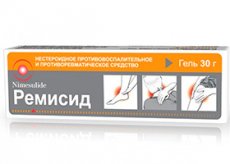Medical expert of the article
New publications
Preparations
Remicade
Last reviewed: 04.07.2025

All iLive content is medically reviewed or fact checked to ensure as much factual accuracy as possible.
We have strict sourcing guidelines and only link to reputable media sites, academic research institutions and, whenever possible, medically peer reviewed studies. Note that the numbers in parentheses ([1], [2], etc.) are clickable links to these studies.
If you feel that any of our content is inaccurate, out-of-date, or otherwise questionable, please select it and press Ctrl + Enter.

Remisid is a drug from the NSAID group of substances; it is a selective inhibitor of COX-2 activity.
The anti-inflammatory effect of the nimesulide component when administered in equimolar amounts at the initial stage of inflammation development can be compared with the action of piroxicam and indomethacin. By slowing down the binding of PG in the inflammation zone, the drug has almost no effect on the processes of synthesis of regulatory PG inside the kidneys and stomach walls.
 [ 1 ]
[ 1 ]
Indications Remicida
It is used for local therapy in cases of musculoskeletal disorders, which are accompanied by inflammation, pain and stiffness of movement. Such diseases include periarthritis, tendosynovitis, osteoarthritis with post-traumatic tendinitis, and muscle strains. It is also prescribed for high-intensity physical activity in relation to joints.
Release form
The component is released in the form of a gel, inside a tube with a capacity of 30 g; in a box - 1 tube.
Pharmacodynamics
The drug inhibits the activity of platelet-activating factor, histamine, tumor necrosis factor α, proteinases, and along with this, the formation of free radicals associated with oxygen.
After external treatment, it leads to a reduction or elimination of pain in the area of application (including pain affecting the joints - both during movement and at rest), reduces joint swelling and stiffness in the morning, and increases the range of motion of the joints.
Dosing and administration
The gel must be used externally. Before the treatment, the epidermis area must be washed and wiped dry. A 3 cm gel strip is required for treatment. It is applied in a thin layer to the affected areas, rubbing in a little. 3-4 such procedures should be performed per day.
The duration of such a course is selected individually, taking into account the result of the treatment. The maximum duration is 1 month.
Use Remicida during pregnancy
It is prohibited to use Remisid during breastfeeding or pregnancy.
Contraindications
Main contraindications:
- severe intolerance associated with nimesulide and other components of the drug;
- infections affecting the skin and dermatitis;
- skin damage;
- use in people who suffer from allergies (expressed in the form of urticaria, bronchial spasms and runny nose) in relation to aspirin or other medications that slow down the activity of PG binding.
 [ 5 ]
[ 5 ]
Side effects Remicida
The use of the gel may lead to local irritation of the epidermis (moderate or mild intensity): peeling, signs of allergy, erythema, itching and rashes. Rarely, people with intolerance have developed anaphylactic symptoms - suffocation, vasomotor rhinitis, Quincke's edema and bronchial spasm.
Overdose
The use of Remisid on a large area of the epidermis or exceeding the required dosage may lead to the appearance of general negative symptoms characteristic of nimesulide and other NSAIDs: headaches, dyspepsia and pain affecting the epigastric region.
It is necessary to reduce the dosage or stop the drug, and also perform symptomatic procedures.
Interactions with other drugs
External treatment with the gel does not lead to the development of interaction with other medications. But it is necessary to take into account that in case of possible passage into the circulatory system, nimesulide is capable of potentiating the toxic properties and effectiveness of many drugs - by displacing them from the synthesis sites with intraplasmic protein with a subsequent increase in the volume of their free fraction in the blood. Therefore, Remisid is very carefully used in combination with phenytoin, cyclosporine, anticoagulants, hypotensive drugs and digoxin, as well as with diuretics, lithium substances, methotrexate, other NSAIDs and antidiabetic drugs for oral administration.
After combined local use of several NSAIDs, local irritation (redness or peeling of the skin and urticaria) may occur.
Antirheumatic drugs (aminoquinolones and gold drugs) and GCS potentiate the anti-inflammatory activity of Remisid.
Attention!
To simplify the perception of information, this instruction for use of the drug "Remicade" translated and presented in a special form on the basis of the official instructions for medical use of the drug. Before use read the annotation that came directly to medicines.
Description provided for informational purposes and is not a guide to self-healing. The need for this drug, the purpose of the treatment regimen, methods and dose of the drug is determined solely by the attending physician. Self-medication is dangerous for your health.

